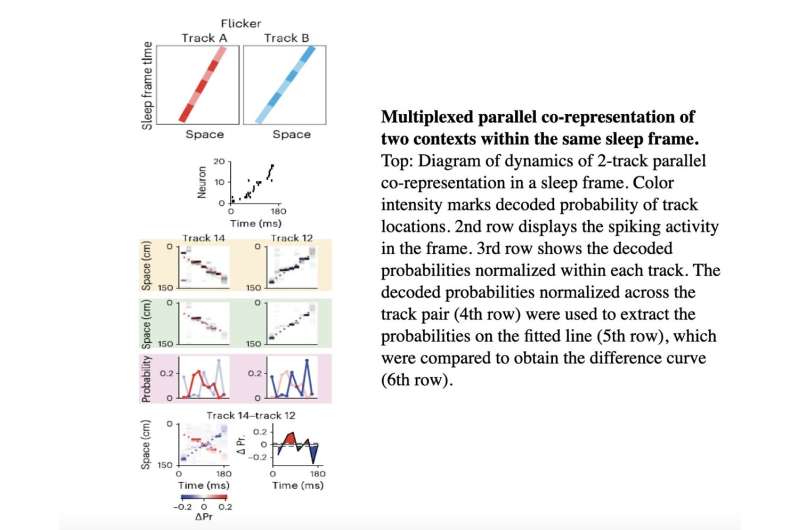August 9, 2024 feature
This article has been reviewed according to Science X's editorial process and policies. Editors have highlighted the following attributes while ensuring the content's credibility:
fact-checked
peer-reviewed publication
trusted source
proofread
Sequence of the day: Exploring how the mammalian brain represents multiple sequential experiences during sleep

Sleep is among the most fascinating phenomena observed in both humans and animals, known to be characterized by different cycles and types of brain activity. Past neuroscience studies have found that during sleep, groups of neurons in the hippocampus replay past experiences and forecast potential future experiences.
Researchers at Yale School of Medicine recently carried out a study investigating how these neuronal ensembles in the hippocampus represent several sequential experiences, or in other words, experiences or events that occur in a specific order.
Their paper, published in Nature Neuroscience, pin-points some of the processes that allow the brain to process numerous experiences during sleep, creating new mental representations that are often based on prior knowledge.
The key objective of the work by this team at Yale was to understand how the mammalian brain organizes several experiences without interference (i.e., encoding new memories without disrupting the older ones). The researchers also set out to explore what the capacity of the brain is for forming memories of multiple experiences occurring during the day and how it generates new representations during sleep.
"You can envision this experiment as an analog for what humans would experience when spending a long day exploring 15 avenues in a new city across the day, with several 1-2 h-long resting epochs in between," George Dragoi, co-author of the paper, told MedicalXpress.
"In this scenario, what do people remember at the end of the day, how is what happened on each avenue being kept separated from what happened on the other ones without a major interference, and how is the overall experience of the day being organized at the whole day resolution, in addition to the detailed experience on each avenue (e.g., the order in which the avenues were visited)?"
To investigate the neural processes involved in the replay and pre-play of sequential experiences during sleep, Dragoi and his colleagues carried out a series of experiments involving freely moving rats. These rats were placed on 15 linear tracks and were allowed to freely explore these tracks.
The team recorded the activity of neuronal ensembles in the animals' hippocampus throughout their track exploration. They also recorded the activity of these neurons during sleep, in sessions before, in between and after the exploration of tracks.
"We recorded this activity at the millisecond timescale resolution from 128 recording channels," Dragoi explained.
"This time resolution is critical to identify the highly time-compressed offline representations during sleep and particularly the fine dynamics of multiplexed flickering representations of two or more experiences within the same event.
"I also think that the physical exploration of linear tracks (as opposed to virtual reality environments, which are currently used at many laboratories) provides the unique opportunity for the animals to be engaged in truly distinct multi-sensory contextual experiences."
The experiments carried out by Dragoi and his colleagues gathered some interesting observations. For instance, the team found that the rats' earliest and most recent experiences during the exploration were more frequently represented in the hippocampus.
While sleeping rats replayed past experiences or pre-played future ones, different experiences were co-represented following specific patterns, which increased their brain's capacity for representations. Moreover, pairs of explored tracks that were close to each other appeared to be connected, producing continuous representations.
Finally, the overall sequence in which the rats had explored the tracks during the day appeared to be re-played in the brain during sleep at hyper-compressed ratios.
"Our findings reveal the large capacity of the brain to process numerous experiences without major interference, particularly by the fast-paced multiplexing of two or more parallel representations," Dragoi said. "In addition, they outline the principles by which representations of multiple experiences can combine in a generative and multiplex manner to result in apparently new representations based on prior knowledge."
The recent study by Dragoi and his colleagues greatly contributes to the understanding of how the rat brain replays past sequential experiences and uses them to create representations of future experiences during sleep. In the future, these researchers' findings could pave the way for further research aimed at further investigating the readout of the processes they uncovered.
"A most surprising and intriguing finding for us was the hyper-compressed representation of multiple experiences spread across a whole day of an animal, in the order in which they occurred within sub-second flashes of higher order sequential reactivation, an index of experiences of that day" Dragoi added.
"We would now like to better understand the readout of the hippocampal computations by the downstream areas, or in other words, how the parallelization on the one hand and binding on the other hand of multiple information processing in the hippocampus impact functionally connected downstream areas."
More information: Kefei Liu et al, Nested compressed co-representations of multiple sequential experiences during sleep, Nature Neuroscience (2024). DOI: 10.1038/s41593-024-01703-6.
© 2024 Science X Network



















